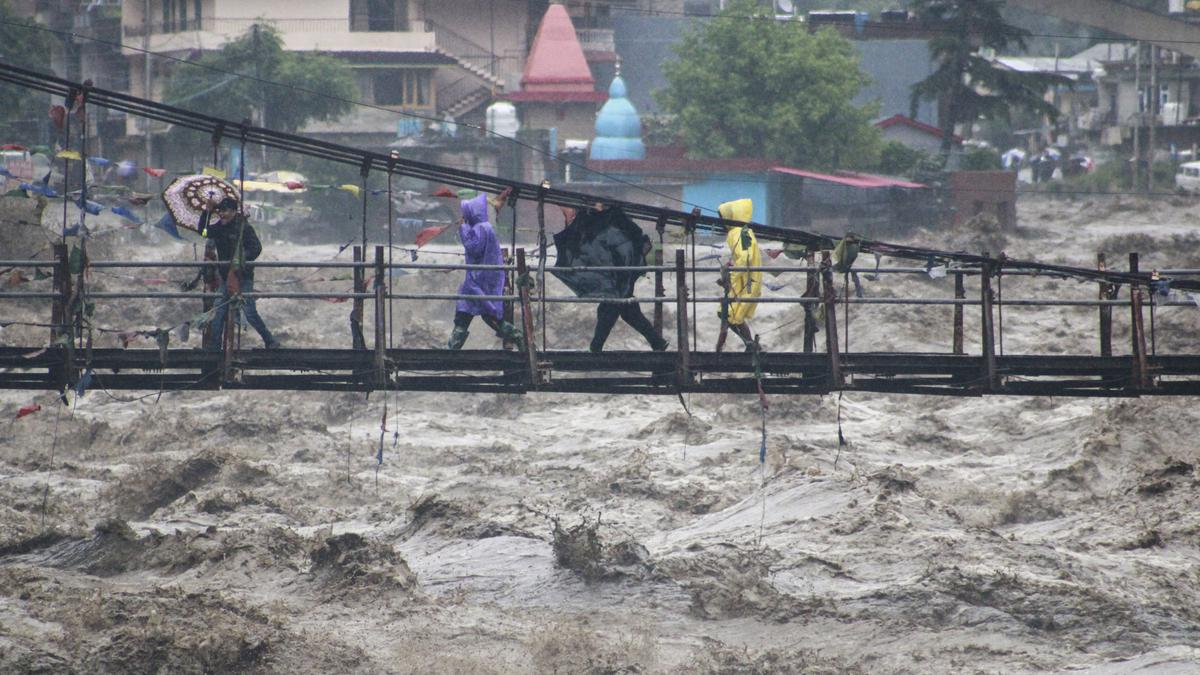Description

Disclaimer: Copyright infringement not intended.
Context
The impact of flash floods and development in the Indian state of Himachal Pradesh.
Details
- Flash floods during this year's monsoon season caused unprecedented damage to lives and assets.
- Death toll exceeds 150, with estimated total losses of ₹10,000 crore.
- Both climate change and human-induced disasters contributed to the calamity.
- Past data shows significant loss of lives and property due to planned development.
Role of Climate Change and Increased Precipitation
- IPCC (Intergovernmental Panel on Climate Change) VI report highlights the impact of climate change on the Himalayas and coastal regions.
- Increased precipitation observed in shorter periods in the Himalayas.
- Instances of rainfall exceeding normal levels in certain years (e.g., 888 mm in 2010, 926.9 mm in 2018).
- This year's precipitation was attributed to the combined effect of south-west monsoon and western disturbances (511 mm).
Reworking the Development Model
- The State's development model initiated in 1971 transformed Himachal Pradesh into a development exemplar.
- Parmar's model focused on land reforms, social welfare, and human resources.
- Successes: Second rank in social development indices, universal electricity access, improved connectivity, and advancements in agriculture.
- Advent of liberalization led to changes, with mountain States required to generate their own resources for fiscal management.
- Exploitation of natural resources, including forests, water, tourism, and cement production, became a focus for development.
Impact of Hydropower Projects
- Hydropower projects became a dominant focus for hill States to attract investments.
- Multilateral agencies' shift in funding priorities to finance large hydropower projects.
- Uncontrolled construction transforming mountain rivers into streams, affecting ecosystems.
- "Run of the river" dams divert water through tunnels, dumping excavated material (muck) along riverbeds.
- During heavy precipitation, dumped muck carried back into rivers, causing further damage.
- Examples of affected rivers: Parvati, Beas, Sutlej, and others.
- Long tunnels planned or commissioned on the Sutlej river leading to ecosystem harm.
- Currently, 168 hydropower projects are in operation, generating 10,848 MW of electricity.
- By 2030, 1,088 hydropower projects are projected to harness 22,640 MW of energy, raising concerns about potential disasters.

Tourism and Road Expansion
- Development-driven road expansion aims to promote tourism and attract visitors.
- National Highway Authority of India (NHAI) involved in road-widening projects.
- Public-private-partnership (PPP) approach prioritizes rapid project completion.
- Bypassing geological studies and mountain engineering skills resulted in vertical mountain cutting.
- Consequences: Massive landslides and damage to existing roads during heavy rain or floods.
Environmental Impact of Cement Plants
- Massive cement plants in districts like Bilaspur, Solan, Chamba causing significant land use changes.
- Contributing to flash floods during rainfall.
- Removal of vegetation reduces land's capacity to absorb water.
Shift in Crop Patterns
- Silent transformation in agriculture and horticulture patterns.
- More farmers are adopting a cash crop economy over traditional cereal farming.
- Short timeframes for transporting perishable crops leading to hasty road construction.
- Lack of proper drainage and dumping areas for muck, causing river ecosystem contamination.
- Resulting rapid swelling of rivulets and rivers even during normal rainfall.
Proposed Solutions
- Institute a Commission of Inquiry involving stakeholders to address policy framework failures.
- Empower local communities over assets and insure them for compensation.
- Adequate changes in infrastructure planning needed to mitigate climate change and development-induced disasters.
|
PRACTICE QUESTION
Q) Analyze the factors contributing to the devastating flash floods in Himachal Pradesh, examining both the impact of climate change and the anthropogenic factors resulting from development. (150 words)
|
.jpg)
https://epaper.thehindu.com/ccidist-ws/th/th_delhi/issues/45125/OPS/GTMBHH32L.1.png?cropFromPage=true
















